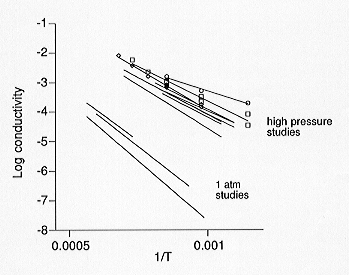

In-situ high-pressure high-temperature complex electrical impedance
spectroscopy has been developed for the multi-anvil press. These experiments
are likely to place tighter constraints on such parameters as the temperature
distribution, fluid content and mineralogy of the Earth's interior when
compared with geophysical observations. We expect this method of determining
the electrical properties of minerals at extreme conditions to be complementary
to diamond anvil cell techniques, and should resolve many of the controversies
brought about by conflicting data sets. The advantages of the multi-anvil
method include a more accurate control and measurement of experimental
conditions such as temperature and chemical environment as well as large
sample volumes for quality sample characterization. For example, trace
amounts of water present in polycrystalline olivine can account for large
increases in its conductivity. This is likely to explain the differences
between high pressure data and 1 atmosphere data obtained in controlled
atmosphere furnaces (Fig. 3.10-7). An important feature in the experimental
design is a sample geometry which accommodates coaxial electrodes. The
sample, 2.5 mm in length, is contained in a 1.8 mm diameter molybdenum
capsule (outer electrode) which is open at both ends. A 0.5 mm molybdenum
wire is inserted through a hole down the cylindrical axis of the sample
as the inner electrode. This geometry minimizes leakage and maintains a
nearly fixed cell constant during compression. An MgO sleeve insulates
the sample from a low voltage (0-1 V), stepped graphite furnace capable
of heating the sample to 1200 °C. Interference from the AC furnace
on the impedance measurements is only observable near 50 Hz. We have made
no additional attempts to shield the sample from the furnace. The complex
impedance can be measured over a frequency range of 10-5 to
107 Hz, making it possible to distinguish and quantify contributions
from both grain interior and grain boundary conduction mechanisms.
 |
Fig. 3.10-7: Temperature dependence of the electrical conductivity of polycrystalline (Mg,Fe)2SiO4 olivine determined at different pressures. The high P studies report significantly higher conductivities than the 1 atmosphere studies due to the inability to keep the sample completely anhydrous at high pressure and temperature. |

Tel: +49-(0) 921 55 3700 / 3766, Fax: +49-(0) 921 55 3769, E-mail: bayerisches.geoinstitut(at)uni-bayreuth.de
 Previous page
Previous page